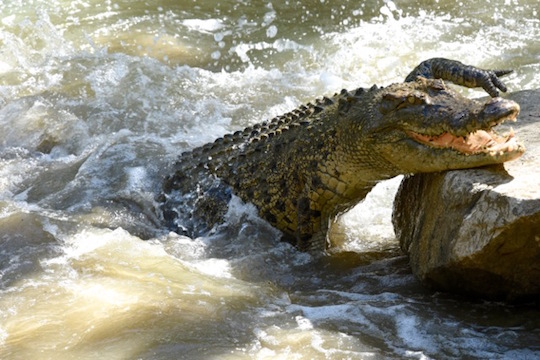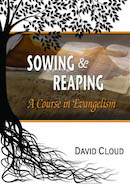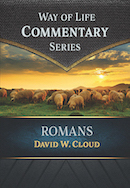866-295-4143, fbns@wayoflife.org

Crocodiles are large reptiles that are members of the Crocodila order, which includes caimans, gharials, and alligators. The word “crocodile” comes from the Greek crocodilos, meaning lizard.
“Crocodiles and alligators are not the same. Crocodiles are larger, have V-shaped jaw and some of their teeth can be seen even when the jaw is fully closed. Alligators are smaller, they have U-shaped jaw and their teeth are not visible when jaws are closed” (“Crocodile Facts,” SoftSchools.com).
There are 13 species of crocodiles, ranging in size from the dwarf crocodile (growing to 5.6 feet and weighing 13 pounds) to the saltwater crocodile (found in southeast Asia and northern Australia). The salty can be a real monster, growing to more than 20 feet long and weighing up to 2,000 pounds, and it is the most aggressive of the crocodiles.
They are cold-blooded and regulate their temperature by sunning, “mouth gaping,” which can cool them down, and other things. They hibernate during cold months and can go dormant during droughts.
They are flesh-eating carnivores that clamp down on prey with their massive jaws, crush it, and then swallow it whole. Having the strongest bite of any animal, the saltwater crocodile can apply 5,000 pounds of closing pressure per square inch. (A human jaw produces 100 pounds, a great white shark 670 pounds, the American alligator 2,200 pounds.) But the croc’s jaw has very little opening power and can be held shut with a large rubber band.
They are fearsome “ambush predators” that usually wait for the prey to come near. They have excellent night vision and a keen sense of hearing and smell. “They can detect both air-borne and water-soluble chemicals.” Their jaws and even their individual scales have sensory pits known as Domed Pressure Receptors (DPRs) that allow them to detect the slightest disturbance in surface water, “detecting vibrations and small pressure changes as small as a single drop.” (Alligators have DPRs only in their jaws.) They can swim up to 25 mph by use of their powerful tails and stay under water for an hour. A croc has 24 sharp teeth and can grow 8,000 new teeth in a lifetime.
Their highly acidic stomach can “easily digest bones, hooves, and horns.”
The crocodile female builds a nest and lays 20-80 eggs, which she “fiercely guards” for three months. It is not wise to mess around with a nesting mama crocodile. “Temperature of the nest determines the gender of the baby. When temperature is 31.6 degrees Celsius - males will develop. Temperature below and above 31.6 degrees induces development of females.” At the time of hatching, the young start calling within the eggs. “They have an egg-tooth at the tip of their snouts, which is developed from the skin, helps them pierce out of the shell. Hearing the calls, the female usually excavates the nest and sometimes takes the unhatched eggs in her mouth, slowly rolling the eggs to help the process. The young is usually carried to the water in the mouth. She would then introduce her hatchlings to the water and even feed them herself.”
The saltwater crocodile is a highly intelligent creature.
It has an amazing homing ability. When a problem Australian croc was flown 250 miles away by helicopter and released, it returned within three weeks (“Relocated 350kg crocodile swims 400km to return to home in North Queensland,” Brisbane Times, Dec. 20, 2015).
Satellite tracking devices have shown that the crocs make intelligent use of water currents and tidal movements.
“In one study by Vladimir Dinets of the University of Tennessee, he observed that crocodiles use twigs as bait for birds looking for raw materials in nesting. The sticks are placed on their snouts and submerge themselves, and when the birds swooped in to get them, the crocodiles would then catch them. Crocodiles only do this in spring nesting seasons of the birds, when there is high demand for sticks to be used for building nests” (Wikipedia, citing “Crocodiles are cleverer than previously thought,” ScienceDaily, Dec. 4, 2013).
The Crocodile’s Eyes
The crocodile’s eyes, together with its ears and nostrils, are located on top of its head, allowing it to lie nearly submerged in the water and thus hidden from prey.
An opaque nicitating membrane protects the eye while allowing vision.
New research has found that the croc’s eyes are perfectly designed for their environment and habits.
“The ‘fovea’, a patch of tightly packed receptors that delivers sharp vision, forms a horizontal streak instead of the usual circular spot. This allows the animal to scan the shoreline without moving its head, according to Australian researchers. ... [PhD student Nicolas Nagloo of the University of Western Australia says,] ‘In the case of crocodiles [the fovea] is spread across the middle of the retina, and it gives them maximum clarity all along the visual horizon.’ This arrangement reflects the predator's iconic ability to lurk with just its eyes above the water, waiting motionless for prey to wander too close to the river's edge” (“Crocodile eyes are fine-tuned for lurking,” BBC News, May 4, 2016).
The crocodile can sleep with one eye open, probably using one brain hemisphere at a time, as some other animals do, including birds while flying long distances.
“Consistent with this idea, the crocs in the study were more likely to leave one eye open in the presence of a human. They also kept that single eye trained directly on the interloper, said senior author John Lesku. ‘They definitely monitored the human when they were in the room. But even after the human left the room, the animal still kept its open eye… directed towards the location where the human had been - suggesting that they were keeping an eye out for potential threats’” (“Crocodiles sleep with one eye watching,” BBC News, Oct. 22, 2015).
- Receive these reports by email
- www.wayoflife.org
______________________
Sharing Policy: Much of our material is available for free, such as the hundreds of articles at the Way of Life web site. Other items we sell to help fund our expensive literature and foreign church planting ministries. Way of Life's content falls into two categories: sharable and non-sharable. Things that we encourage you to share include the audio sermons, O Timothy magazine, FBIS articles, and the free eVideos and free eBooks. You are welcome to make copies of these at your own expense and share them with friends and family. You may also post parts of reports and/or entire reports to websites, blogs, etc as long as you give proper credit (citation). A link to the original report is very much appreciated as the reports are frequently updated and/or expanded. Things we do not want copied and distributed are "Store" items like the Fundamental Baptist Digital Library, print editions of our books, electronic editions of the books that we sell, the videos that we sell, etc. The items have taken years to produce at enormous expense in time and money, and we use the income from sales to help fund the ministry. We trust that your Christian honesty will preserve the integrity of this policy. "For the scripture saith, Thou shalt not muzzle the ox that treadeth out the corn. And, The labourer is worthy of his reward" (1 Timothy 5:18). Questions? support@wayoflife.org
Goal:Distributed by Way of Life Literature Inc., the Fundamental Baptist Information Service is an e-mail posting for Bible-believing Christians. Established in 1974, Way of Life Literature is a fundamental Baptist preaching and publishing ministry based in Bethel Baptist Church, London, Ontario, of which Wilbert Unger is the founding Pastor. Brother Cloud lives in South Asia where he has been a church planting missionary since 1979. Our primary goal with the FBIS is to provide material to assist preachers in the edification and protection of the churches.
Offering: Offerings are welcome if you care to make one. If you have been helped and/or blessed by our material offerings can be mailed or made online with with Visa, Mastercard, Discover, or Paypal. For information see: www.wayoflife.org/about/makeanoffering.html.





